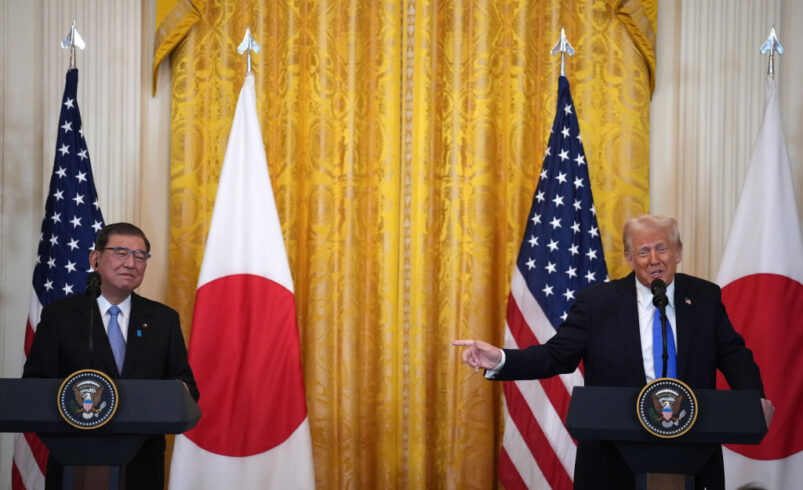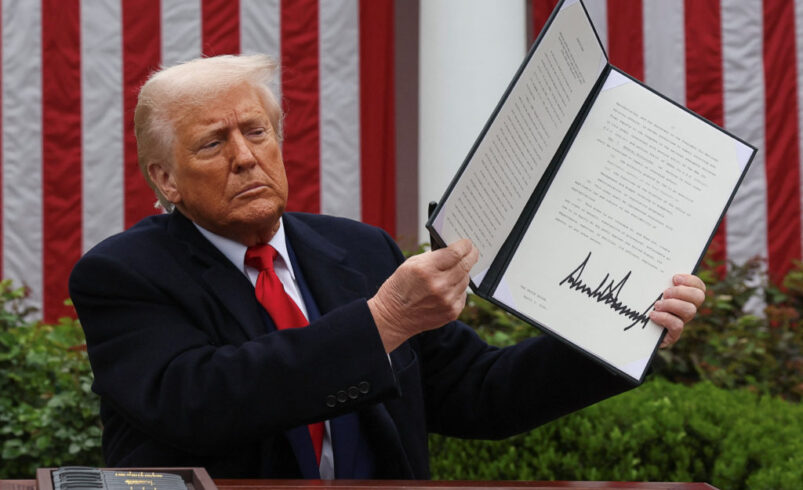
Trump’s Aggressive Tariffs on Japanese Imports Can Rattle Japan’s Economy 2025
In an unexpected policy shift, U.S. President Donald Trump has reintroduced sweeping tariffs targeting foreign goods, with a sharp focus on Japanese imports. This move, announced under the rhetoric of “restoring economic fairness,” is sending ripples through global markets and creating unease among international partners. Japan, a longtime ally and the fourth-largest trading partner of the United States, is especially vulnerable due to its economic structure and trade dependency.
This renewed protectionist strategy, particularly the 24% tariff on Japan’s exported goods and an additional 25% levy on foreign-made automobiles, has left policymakers and economists scrambling to assess its potential fallout. Although this approach echoes the previous administration’s trade-war tactics, the scale and targeting of these new tariffs underscore deeper shifts in U.S. economic strategy, one that prioritizes domestic production over long-standing alliances.
The Automotive Industry Takes a Direct Hit
Among the sectors most exposed to the tariffs, Japan’s automotive industry stands out. It is not only the pride of the nation’s industrial base but also a cornerstone of its export economy. Vehicles and automotive parts collectively form a substantial portion of Japanese exports to the U.S., and a price hike resulting from these tariffs could significantly dent their appeal in American markets.
Major Japanese automakers like Toyota, Honda, Nissan, and Subaru rely heavily on U.S. sales. While some models are manufactured domestically in the U.S., many high-value components and fully assembled cars are still shipped from Japan. The additional duties imposed by the U.S. will almost certainly inflate sticker prices, leading to a likely drop in consumer demand. As buyers seek more affordable alternatives, automakers may be forced to scale back production, reduce investment, or absorb some of the tariff costs, squeezing profit margins.
Currency Fluctuations and Market Volatility
Markets quickly reacted to the tariff announcement with a wave of volatility. Japan’s Nikkei 225 index fell by nearly 3% following the news, a reflection of investor anxiety about reduced trade volumes and diminished earnings for export-driven corporations. Simultaneously, the Japanese yen appreciated against the dollar, traditionally seen as a safe haven during periods of global instability.
However, a stronger yen is double-edged—it benefits importers but burdens exporters, making Japanese goods even more expensive overseas. This currency movement further exacerbates the challenges posed by U.S. tariffs, potentially creating a compounded drag on Japan’s GDP growth.
Policy Response from Japan
Japan’s political and economic leadership has reacted swiftly, though cautiously. Prime Minister Shigeru Ishiba called the new tariffs “difficult to understand,” especially given Japan’s substantial contributions to the American economy through job creation and investment. The government is exploring diplomatic channels to secure an exemption from the tariffs and prevent escalation.
Trade Minister Yoji Muto described the decision as “extremely regrettable,” highlighting the risks it poses to stable international economic relations. Japan is expected to raise this issue in upcoming G7 and WTO meetings, advocating for a rules-based trading system and mutual respect among partners. Meanwhile, Tokyo is reportedly considering fiscal support measures for affected industries to cushion the immediate shock.
Impact on Monetary Policy
The Bank of Japan (BOJ), which had been inching toward a tightening cycle after years of ultra-loose monetary policy, may now reconsider. The sudden external shock introduces a new layer of uncertainty, potentially weakening consumer and business sentiment. Economists believe the central bank may postpone any planned interest rate hikes and revise its economic forecasts downward in response to the increased downside risks.
Deputy Governor Shinichi Uchida recently indicated that while inflation remains on track, geopolitical developments like U.S. tariffs could complicate the trajectory. Delayed monetary tightening, in turn, could influence currency markets, asset prices, and borrowing conditions across Japan.
Global Repercussions and Trade Diplomacy
Japan is not the only country affected by Trump’s latest trade maneuvering. The new tariff framework applies across the board to several foreign nations, including Germany, South Korea, and China. Still, the targeted nature of the automotive duties—where Japan holds a major share—makes it uniquely vulnerable.
From a broader perspective, this development represents a regression in multilateral trade diplomacy. It undermines efforts to build inclusive economic cooperation in the Indo-Pacific region, where Japan has led initiatives like the Comprehensive and Progressive Agreement for Trans-Pacific Partnership (CPTPP).
Moreover, these tariffs could encourage retaliation, creating a domino effect of protectionist policies that fragment global supply chains and reduce efficiency. For countries already facing inflationary pressures and slowing growth, such moves could be economically destabilizing.
Domestic U.S. Implications
While the tariffs aim to benefit American manufacturers and labor by leveling the playing field, their real-world impact may be mixed. Higher prices on foreign goods, especially cars, could lead to reduced consumer choice and increased inflationary pressure—ironic given the current policy focus on cost-of-living relief.
In addition, U.S. companies that rely on components from Japan for their operations might face input cost spikes, leading to delays, inefficiencies, or higher end-user prices. Supply chains, already tested by COVID-era disruptions and geopolitical tensions, could experience renewed strain.
The Road Ahead for Japanese Imports: Negotiation or Escalation?
Whether this trade flashpoint results in long-term damage or a negotiated recalibration depends on how both sides proceed. Japan has historically favored measured responses and might seek to de-escalate through diplomacy rather than counter-tariffs. However, domestic political pressures may push leaders to respond decisively if Japanese firms begin reporting severe losses.
For the U.S., the question is whether this protectionist turn delivers meaningful industrial gains or backfires by alienating key partners and inviting retaliation. The answer will have implications not only for Japan but for the entire global trading system.
Conclusion
The imposition of new tariffs on Japanese imports marks a significant turning point in U.S.-Japan economic relations. While aimed at boosting domestic production, these measures risk undermining critical alliances and slowing global economic recovery. As the consequences unfold, the world watches to see whether this is a prelude to deeper trade realignment or a temporary disruption in a historically stable partnership.













